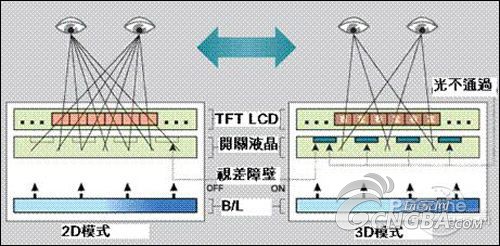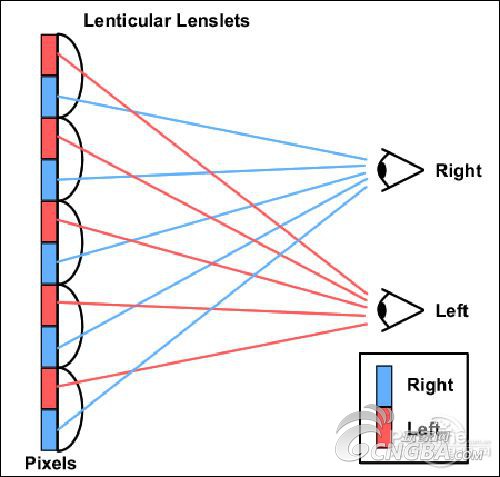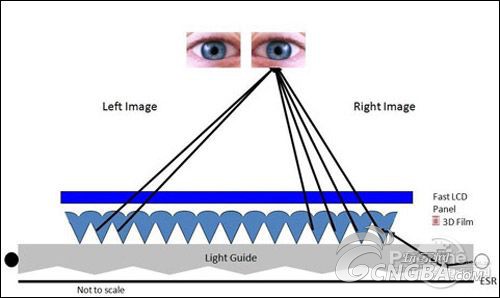At present, 3D display technology can be mainly divided into eye-type and naked-eye type. Eye-type 3D display technology has developed earlier and the solution is relatively mature. It has been applied in commercial fields for many years. The 3D flat-panel TVs that have been listed this year are all eye-based products. . However, eye-type 3D TVs need to wear customized 3D glasses, which may be inconvenient for consumers who already wear glasses. The naked-eye 3D allows viewers to enjoy the 3D effect because it does not require additional equipment. It is widely welcomed by consumers and the attention of manufacturers. The naked-eye 3D technology is the development direction of 3D display technology.
This article refers to the address: http://
- Bare-sighted 3D display technology
From a technical point of view, the naked eye 3D can be divided into three types: Barrier, Lenticular Lens, and Directional Backlight. The biggest advantage of the naked-eye 3D technology is that it is free from the constraints of glasses, but there are still many shortcomings in terms of resolution, viewing angle and visual distance.
During viewing, the viewer needs to maintain a certain position with the display device to see the 3D effect image (the 3D effect is greatly affected by the viewing angle), and there is still a certain gap between the 3D image and the common polarized 3D technology and the shutter 3D technology. . However, LCD panel industry giant AUO, R&D giant 3M and others have been actively researching and developing. It is expected that some naked-eye 3D display devices will be mass-produced this year and next.
Light barrier
Light barrier 3D technology, also known as parallax barrier or parallax barrier technology, is similar in principle to polarized 3D and has been successfully researched by Sharp's European laboratory engineers for more than a decade. The light barrier type 3D product is compatible with the existing LCD liquid crystal process, so it is advantageous in terms of mass production and cost, but the image resolution and brightness of the product using this technology will decrease. The light barrier type 3D technology is realized by using a switch liquid crystal panel, a polarizing film and a polymer liquid crystal layer, and using the liquid crystal layer and the polarizing film to produce a series of vertical stripes with a direction of 90°.

These stripes are several tens of micrometers wide, and their light forms a vertical thin-gate pattern called a "parallax barrier." The technology utilizes the parallax barrier disposed between the backlight module and the LCD panel. In the stereoscopic display mode, when the image that should be seen by the left eye is displayed on the liquid crystal screen, the opaque stripes will block the right eye; similarly, When the image that should be seen by the right eye is displayed on the LCD screen, the opaque stripes will block the left eye, and the viewer can see the 3D image by separating the visible images of the left and right eyes.
Advantages: Compatible with existing LCD liquid crystal processes, so it is more advantageous in terms of mass production and cost
Disadvantages: the brightness of the picture is low, and the resolution is inversely proportional to the increase in the video output at the same time.
Cylindrical lens
The Lenticular Lens technology, also known as lenticular or microcolumn lens 3D technology, has the greatest advantage that its brightness is not affected. The principle of the lenticular lens 3D technology is to add a lenticular lens to the front of the liquid crystal display so that the image plane of the liquid crystal panel is located on the focal plane of the lens, so that the pixels of the image under each cylindrical lens are divided into several sub-pixels. This allows the lens to project each sub-pixel in a different direction. Then the eyes look at the display from different angles and see different sub-pixels. However, the gap between pixels is also amplified, so the sub-pixels cannot be simply superimposed. Let the cylindrical lens be parallel to the pixel column, but at an angle. This allows each set of sub-pixels to be repeatedly projected into the viewport instead of just projecting a set of disparity images.

The reason why its brightness is not affected is because the lenticular lens does not block the backlight, so the brightness of the picture can be well protected. However, since its basic principle of 3D display is still similar to the parallax barrier technology, resolution is still a difficult problem to solve.
Advantages: 3D technology shows better results and brightness is not affected
Disadvantages: Related manufacturing is not compatible with existing LCD liquid crystal processes and requires investment in new equipment and production lines.
Pointing light source

3M pointing light source 3D technology
Mainly invested in Directional Backlight 3D technology, 3M Company, Directional Backlight 3D technology with two sets of LEDs, with fast response LCD panel and driving method, to make 3D content sorted. The way to enter the viewer's left and right eye interchangeable images produces parallax, which in turn makes people feel the 3D three-dimensional effect. Not long ago, 3M has just demonstrated its successful 3D optical film. The interview of this product enables real 3D stereoscopic images to be displayed on mobile phones, game consoles and other handheld devices without wearing 3D glasses. Mobile-based communication and interaction.
Advantages: resolution, light transmittance can be guaranteed, will not affect the existing design architecture, 3D display is excellent
Disadvantages: technology is still developing, products are not mature
We supply all kinds of flexible 3-Point adjusted lamp,whose arm allow you to control the light and to direct and aim it to wherever you need it, what's more, it's easy on the eyes, non-flickering light for stress-free productivity. Avoid eye fatigue caused by flickering lights and harsh glares.
Durable premium aluminum alloy with select few ABS material finish, enjoy perfect vision beauty and long lasting performance.Elegant design is both functional and stylish, give us a sense of ritzy and also good for decoration.
Study Desk Lamp,Eye-Care Study Desk Lamp,Study Desk Table Lamp,LED Study Desk Lamp
Shenzhen Superlight Technology Co., Ltd. , http://www.superlighttech.com